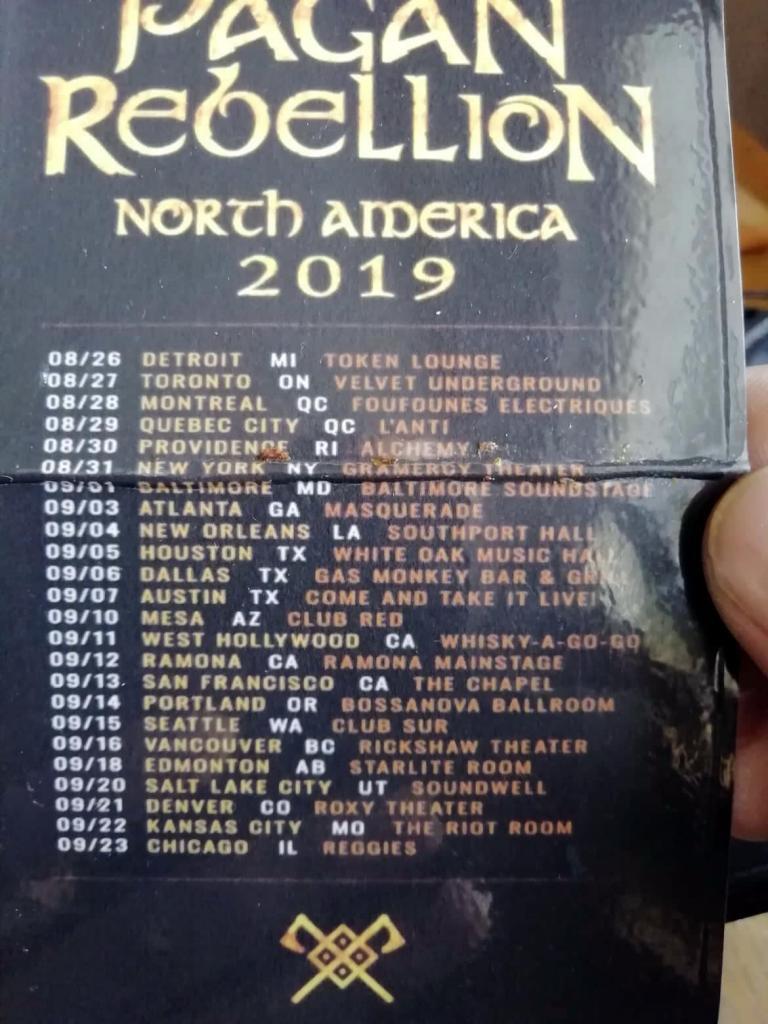It’s not very common that Estonian musicians and bands tour in the United States, less so that they perform in 24 North American cities and towns in both the US and Canada; the Estonian heavy-metal band, Metsatöll, did just that in September – starting in Detroit and finishing in Chicago.
Before the concert in Chicago, I had seen Metsatöll once, ages ago in Estonia. I’m not a very big heavy metal buff (I’m more of a classic rock type) and therefore I was a little sceptical before attending the band’s final concert in North America – at a small music venue called Reggie’s in Chicago’s Near South Side neighbourhood. But something about the fact that an Estonian band is performing in the US – and, especially, that it had just toured the best part of the North American continent – seemed so outrageously cool that skipping it wasn’t really an option.
And I’m really glad I went. There’s something powerful about Metsatöll’s music, but I believe it was made more powerful by the fact that, you’re in Chicago, in America, and suddenly there’s a band on the stage singing in the Estonian language. With local Estonians (and Russians, and Americans) jumping up and down in front of the stage, many of them singing along, everybody having a seriously good time. And that proved to me that even if you’re not a fan of a specific genre, it’s possible to enjoy it to the fullest when the circumstances are right.
This wasn’t the first time Metsatöll (according to the band, the name is an ancient Estonian euphemism for wolf; “mets” means “forest” in Estonian, and “töll”, according to Wikipedia, is a “four-legged being”) was touring in America – it was their fourth. This time, however, they came on the tour with Arkona, a Russian folk-metal band with whom they had previously toured in Europe.
Creating a perfect synergy
“We know them for years already,” Markus Teeäär, Metsatöll’s lead singer and guitarist, says. “There was a time when they weren’t very well-known, but now they’re very famous in both Europe and America. And their manager called us up and invited us on the tour.”
“They are very cool and nice people,” Metsatöll’s drummer, Tõnis Noevere, adds. “When the agency offered a tour with them, we were interested right away.”
And it makes perfect sense. Both Metsatöll and Arkona play similar music, ranging from heavy metal to folk metal; both bands sing in their native languages and create a perfect synergy between them. In the most recent North American tour, Metsatöll was the warm-up band for Arkona, but since they cater for the same audience, it felt more like a concert of two equal bands, both of whom were there in their own right, playing and singing for the same audience, both enjoyable for Estonians, Russians, Americans and every other person there alike.
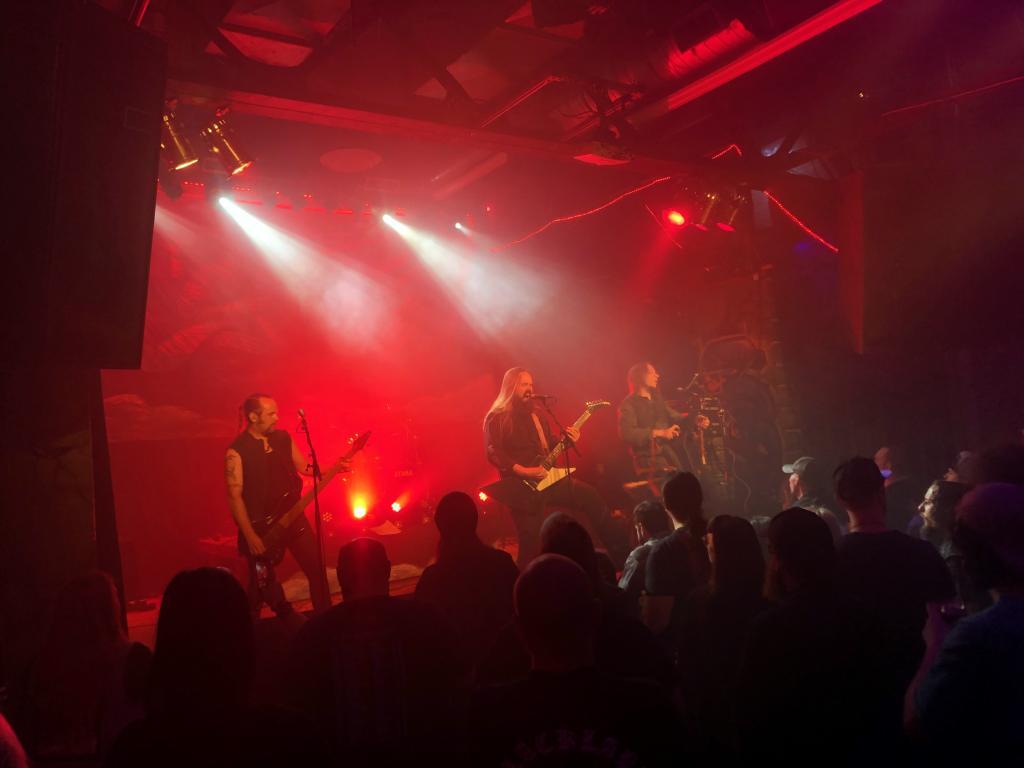
Metsatöll isn’t a particularly old band. Well, it is, and it isn’t. The band just celebrated its 20th anniversary – which makes it a little younger than the post-Soviet occupation Republic of Estonia. But let’s face it, the history of world music is full of one hit wonders; only a fraction of bands has lasted years – let alone almost a generation.
In its 20 years, Metsatöll has produced eight studio albums (the most recent one, Katk Kutsariks – roughly translated as Plague as a Coachman – came out in 2019), given over 700 performances in Estonia, the rest of Europe and North America, and sold more than 80,000 records. The band uses traditional Estonian folk music elements in its music, combining folk music with heavy metal, and playing instruments like the kannel (a type of Estonian harp), bag pipes and flutes.
Only two concerts with no Estonians in the audience
So no wonder they were very warmly welcomed in the US and Canada.
Markus: “At most concerts, we had 250-500 people in the audience, even more.”
Tõnis: “We also had very big concerts, for example, in New York, San Francisco, Toronto, Hollywood. The audience there was 500-plus people.”
“California was the most successful in this tour,” Markus notes. “We performed at Whisky-A-Go-Go in Los Angeles, and the most powerful of our concerts was in San Francisco – that one raised the bar very high. The concerts we left with California were way better than the others. But we also feel very good in Texas.”
“For me, it was interesting to see the attitude of the audience in different states,” Tõnis says. “For example, in Texas we saw many heavy-metal fans in cowboy hats and chequered shirts. California, on the other hand, is much more liberal. New York was the most Europe-like.”
Among the 24 cities where the band performed, they only saw two concerts with no Estonians in the audience – in New Orleans, LA, and Mesa, AZ.
“We met Estonians everywhere and it always makes us feel so warm and homely,” Markus says. “At every concert we dedicate one song to Estonians and you always see people’s arms high up.”
“We always interact with the local Estonians in the Estonian language and therefore recognise them immediately,” Tõnis adds. “Usually the local Estonians come to chat with us after the concert, that is very nice.”
Possible new estophiles
Lauri Õunapuu, the band’s bagpiper, states that the local Estonians always ask whether the band members would come and spend some time with them, either before or after the concert. “We always do it when we have time. It’s very nice to get out of the routine and chat, relax and listen to how Estonians live in the far-away American land. All their stories – how they ended up in the US, what are they doing there and what is their ‘story’ – these are always very fascinating.”
Americans, too, seemed to be very fond of the Estonian band. “We met some old fans. I remember a fan in Kansas City who was such a great admirer that he had seen Metsatöll every time we had visited the US. He had all our records and he told us that he listens to Metsatöll every day on his Spotify playlist. This time, he had lobbied the managers to be our warm-up with his band. He said it was the best day of his life,” Tõnis describes.
Markus adds that the band’s new album was also welcomed very well. “In many cities we were invited back – and we were only the warm-up band. We were out of our vinyls after eight concerts, that should speak of some success.” Tõnis also notes there were people who said the latest album was the band’s best.
“It was also exciting that many fans whom we had met before had learned quite a few Estonian words,” Lauri says. “I don’t know if they’re new estophiles, but it was still a nice surprise. Let’s say, a display of respect.”
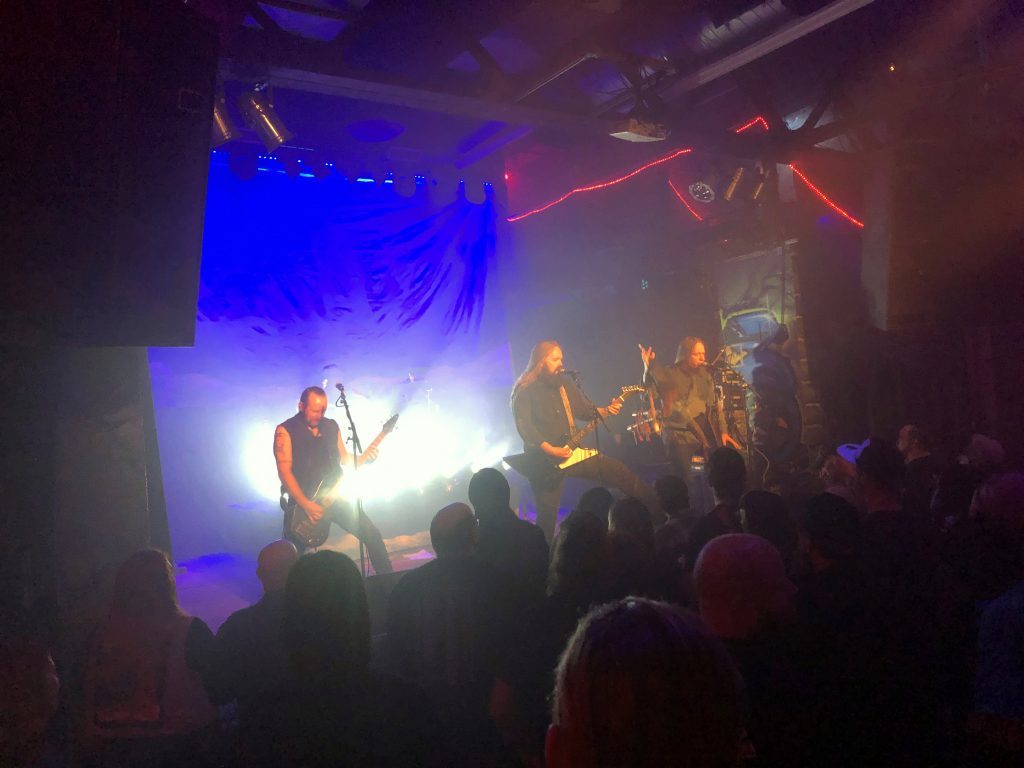
According to Markus, the latest North American tour was the best tour for Metsatöll. “We were really, really pleased with it. Everything was positive, very comfortable. I had never been on a tour that goes so perfectly that it’s scary – what’s going to happen now? Is the returning flight going to crash or something?” he jokes. “We had a good run, lots of work, everything was very cool about this tour.”
Thousands of miles on a Nightliner bus
“The schedule was very intensive, we only had four days off,” Tõnis says. “We rode 10,232 miles in the tour bus, but we were still very pleased, and it was well worth it. The concerts were cool and the audiences awesome.”
The band started its tour from Chicago, where their plane landed – but they didn’t perform on the first night. Instead, the local Estonians took them and their gear to the Estonian House in Riverwoords, IL, where the band members mingled with the crowd and enjoyed the sauna. On the next day, they packed themselves and their gear on a Nightliner bus and off they went.
“Our first concert was in Detroit. From there we went to Canada, we performed in Toronto, Montreal and Quebec City. Then back to the States, first to Providence (RI – editor). After that New York, Baltimore, Atlanta, New Orleans, Houston (TX – editor), Dallas, Austin (TX – editor), Mesa (AZ – editor), West Hollywood, Ramona (CA – editor), San Francisco, Portland (OR – editor) and Seattle. Then we went back to Canada to perform in Vancouver and Edmonton. And the last concerts of the tour were back in the US, in Salt Lake City, Denver, Kansas City (MO – editor) and Chicago,” Tõnis describes the tour.
“People are often surprised, how can a band be on a tour for an entire month,” Lauri mentions. “We’re usually fortunate to attend tours where we live in these Nightliner buses – these have a kitchen, TVs, audio equipment, couches, a restroom and of course beds. Our buses have been different, some smaller, some bigger – but always meant for the band to feel at home and well-rested for the next day.”
Americans are louder and moodier than Europeans
“Our bus driver, by the way, was a very friendly former musician from the Mexican band, Los Fugitivos – and after a little homework we realised that Edi – that was his name – was far more famous than any other musician in our tour bus will ever be. Imagine – millions of sold records, toured in 70 countries, and their tours usually lasted nine months.”
For Tõnis, this was his first American tour ever. “For me, everything was new and interesting. The audience in America is louder and moodier than in Europe. In Finland and Germany when you see the audience is tapping its feet (to the beat of the music – editor), you know you’ve got them and they’re fully enjoying you. In America, in most of the cities, you have a proper singing and dancing festival from the very first note.”
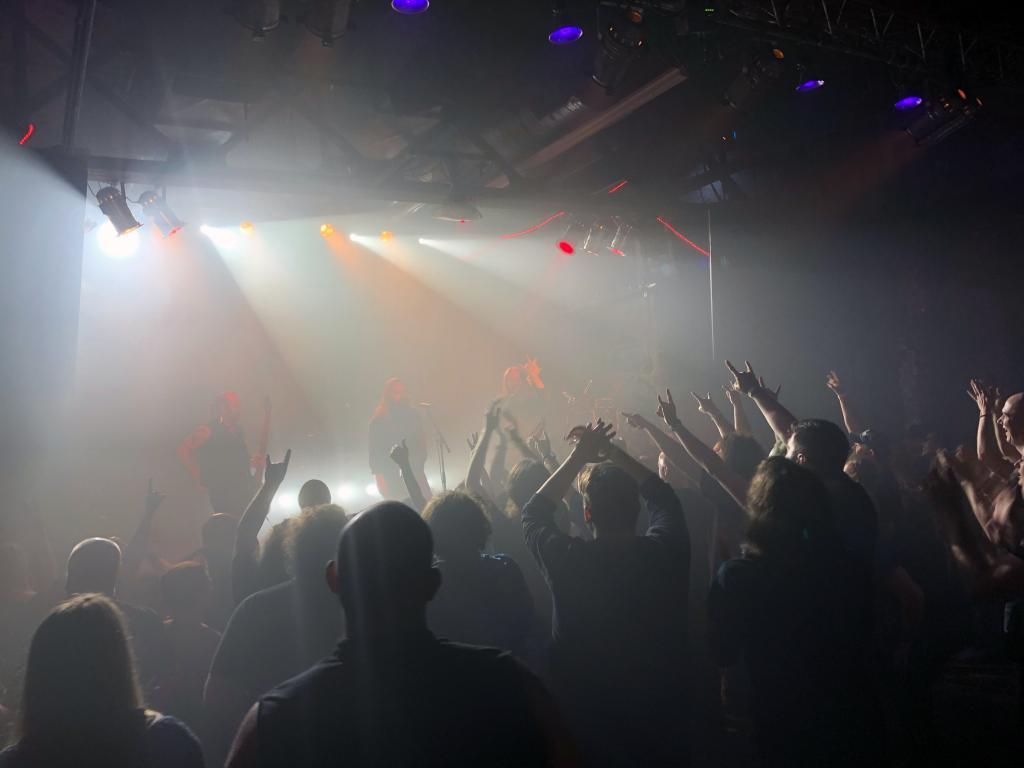
“Overall, an American agency is, compared with a European one, quite lazy. In Europe, the bands’ catering and everything else is usually very well taken care of. In the US, the agencies normally give the band members extra money so that they can go eat on their own. So that they wouldn’t have to order a catering service, but it leaves them with more time to deal with promoting of the tour, so that enough people would be in the audience. That was very well taken care of by the Americans.”
Wishing to have more time to see more
The members of Metsatöll say they like North America a lot and they wish they would come back. “I’d like to have more time to visit these beautiful places,” Lauri says. “When you’re on a tour, you mostly see cities, suburbs and endless roads that lead you to the next city or suburb. You see on the photos there are beautiful places you’d like to go, but when you arrive in a city you realise that these places are an hours’ walk away and so you never get there. I hope the next time we come, with the help of the locals, we get to visit these beautiful places and stay there long enough to enjoy the beauty.”
And actually, the next time might not be that far away. The band members have one-year US work visas, so they’d like to come again as soon as possible. “We should quickly do another tour and visit also Minnesota and Florida where we didn’t go this time. And in Winnipeg and Calgary in Canada,” Markus hopes.
On the other hand, there are other places in the world they’d like to visit, too. “We’re trying to find opportunities to visit places in the world where Estonian bands rarely go – Asia, Australia, South America,” Lauri notes. “But I must say that this would be even more complicated than travelling to America – we probably need to find good friends who’d invite us to go with them.”
A funny story about the tour to tell the grandkids
Every band tour surely includes something interesting, funny or memorable – either a story or an event. So did this one.
Tõnis: “We had just finished the concert in Providence. Lauri and I went out for a smoke. And a topless black girl came to us and asked us for a cigarette – which, of course, we couldn’t refuse. After she got her cigarette, she asked us, ‘How long have you been together?’ Lauri replied, ’20 years!’ The girl then said, ‘Oh, nice,’ and went to the club next door – a gay club.”
Lauri: “Another interesting story was about our Mexican superstar bus driver. He wanted to see a bear when we were driving in the mountains and was constantly talking about how he had been driving for years and never seen a bear. Even though they were supposed to live there. And how ‘everyone else’ had always seen them.
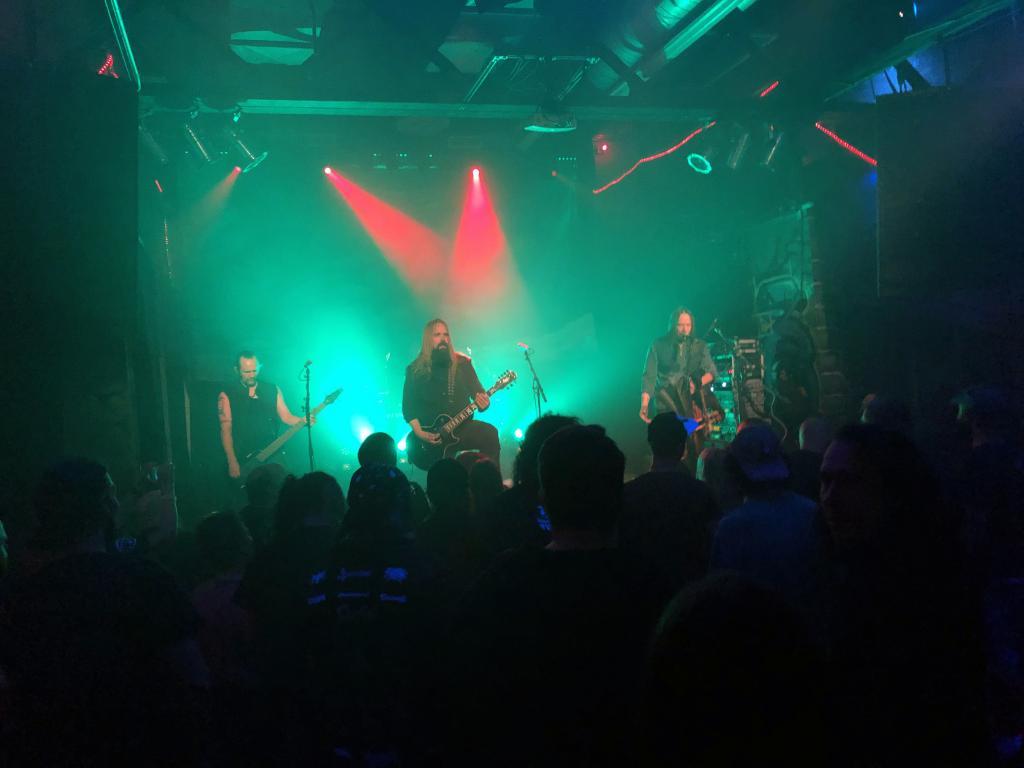
“Then we had a day off in El Paso. And the first thing Tõnis bought from a local store was a bear costume. So, that’s how, on our day off, we had a real bear among us. Well, almost. Also, our base guitarist, Raivo, bought a small teddy bear as a present for Edi, so that he’d see a bear when he wants to.”
20 years of Metsatöll
This year, the band celebrated its 20th anniversary – of which the North American tour is also part. “It’s our birthday year and, throughout the year, we tried to engage in many projects related to that,” Tõnis tells. “First, we released a new album and celebrated that at Rock Café (a concert venue in Tallinn – editor) with the Estonian National Men’s Choir. We also performed with the Estonian Police and Border Guard Orchestra with whom we played our songs. It’s a powerful feeling to play our own songs together with an orchestra.”
“And, of course, the North America tour,” Tõnis continues. “We also released a craft vodka to celebrate our birthday. It’s called ‘Metsaviha VI’ (Woodwrath VI – editor).”
“We have a video from our birthday celebration. One of our songs is called ‘Koduhiite kaitsel’ (In Defence of the Home Groves – editor), it’s also on YouTube, and it’s sung by Marko Matvere (a famous Estonian actor and singer – editor) – it’s on our new album, too. Find it online, it’s a very spiritual and nice song,” Markus adds.
Cover: Metsatöll performing live in Chicago on 23 September 2019. From the left: Raivo Piirsalu, Markus Teeäär, Lauri Õunapuu. Photo by Sten Hankewitz.


